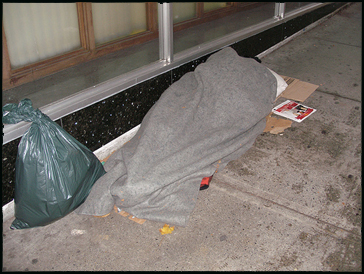
Washington, D.C., is the capitol of the greatest country on Earth. (Anybody who disagrees, don’t get excited. That’s kind of like saying America is the healthiest patient in the hospital — in other words, sick, sick, sick.) In the metropolitan area constituting the capitol of the greatest country on Earth, around 12,000 people are experiencing homelessness.
Say what? Don’t they mean 1,200? No, they mean 12 thousand, give or take. People who don’t possess addresses are notoriously difficult to count. What we know for sure is that the District of Columbia has one of the highest homelessness rates in the country.
We’ll get back to that, after starting with the good news. On November 23, 100,000 caring Americans turned out to peacefully demonstrate on the National Mall. The occasion was the annual “Help the Homeless” walk, and Khadijah Norman tells us about it in The Hoya, which is the student newspaper of Georgetown University:
The walkathon raises money for the more than 12,000 people in the District who are living without shelter of their own. Since its beginning in 1988, the walk has raised $80 million toward relief efforts.
The university sent two busloads of folks from the Hoya Outreach Programs and Education (HOPE) and other student groups. Victoria Glock-Molloy, who is the co-chair of HOPE, told the reporter that Georgetown students raised at least $1,500 for the cause.
So… what else is going on in the capitol of the nation that wants to show every other country on Earth the right way to do things? For starters, the concept of a living wage has gone the way of the unicorn and the zoot suit. Washington, D.C., has more people than anyplace else in the country getting along at less than half of the “poverty level.” Imagine that, not even making enough money to qualify as poor. What a sorry condition for the capitol of the greatest country in the world to be in.
And now it’s winter, compounding all the problems. Kathryn Baer of Change.org explains the tangle of difficulties and proposed solutions for people experiencing homelessness in Washington, D.C., and is it ever complicated. Okay, the local government is more progressive than some. That’s a plus. Another plus is having Tommy Wells of the Interagency Council on Homelessness on the case. That’s about it for the positive aspects. Because even the most well-intentioned and determined councilmember cannot make the available limited resources stretch to meet the need.
So lines have to be drawn, and that’s where the truly sticky problems start. What the Council wants to do is get everybody in out of the cold, and there just aren’t enough places to put them. There is an emergency shelter for families, called DC General, and it’s not a good place. It’s better than outdoors, but only marginally. Baer says,
Many families sleeping on cots in what was supposed to be the recreation room. Families sleeping in hallways. Some in closets. Other extraordinarily unhealthy conditions due at least in part to the overcrowding — rats, roaches, mold, etc… The downsides to communal housing for families should be obvious. Children at risk of abuse from strangers. Conditions in which communicable diseases can spread — a significant risk not only for children, but for adults with diseases like AIDS that impair their immune systems. No private, quiet space where children can study and families as a whole maintain some facsimile of normal life.
Because Washington is trying harder than some surrounding areas, it’s catching the overflow from other places within traveling distance. Which means that stricter documentation requirements have to come into play. It’s hard for people to prove that, although they don’t live anyplace, the noplace where they don’t live is the bureaucratically correct noplace. Yet these restrictions have to be made, in fairness to the taxpayers in the area where help is being offered.
The mass of people experiencing homelessness includes some subgroups with even more serious concerns, such as women and children escaping from domestic violence. They don’t want the person they have fled from to be able to find out where they are.
Meanwhile, the temperature outside is dropping. If you’re particularly interested in the Washington, D.C., area and want a crash course on what’s going on there, please consult Kathryn Baer’s blog, “Poverty & Policy,” which celebrates its second birthday today. It’s no-frills and fact-packed, and Baer is wonderfully adept at delineating the issues and making sense out of official information.
Reactions?
Source: “Students Hit Pavement for Homeless,” The Hoya, 11/23/10
Source: “Washington, D.C. Homeless Endangered by Proposed Restrictions,” Change.org, 11/27/10
Image by quinet (Thomas Quine), used under its Creative Commons license.
0


